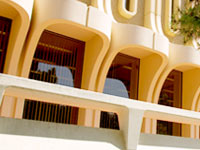


 Julia Gelfand
Julia GelfandI am the Applied Sciences & Engineering Librarian for Information and Computer Sciences, Engineering, & the Planning, Policy & Design Department in the School of Social Ecology. I also support the interdisciplinary research units on the campus and help them thrive with access to resources.
I became a librarian at a research university because I wanted to be a part of a dynamic academic research enterprise. I am the daughter of two humanities professors who grew up on university campuses and was exposed to the joys of discovery, intellectual discourse and creative ideas from an early age.
Change is constant and good. Libraries used to be warehouses of print inventories. Today, they are centers for technology and knowledge generation. One does not need to rely upon coming to the Library for information any longer but the Library and its staff can offer filters that enhance the relevance of information for one’s needs.
I think of how I can provide new services to my library users integrating the traditions of the past with the technologies of the present while we anticipate what the future will allow.There are cures to be found for illness, technology erupts with new pathways, and innovation leads to invention. We learn from the past and must archive and secure it, and remember that people learn in very different ways.
So what do librarians do today? They read, search, dig, organize, observe, teach, create, mix, listen, document, create, archive and try and stay present as we work with a diverse body of users, each on a different quest for something important. I think of how I can provide new services to my library users integrating the traditions of the past with the technologies of the present while we anticipate what the future will allow.
In our spare time, my husband and I collect pigs made in all materials that come from exotic places, and we have an extensive collection of literature where pigs are the primary subject or are illustrated in memorable artwork. We also like to travel and visit artists that we read about and the media in which they work. We collect examples of their work as reminders of visits to remote and off-the-beaten-path locations.